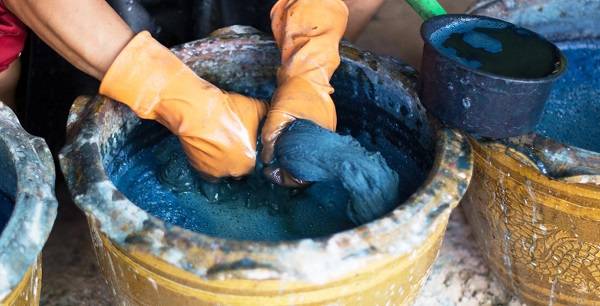
Renewed interest in eco-friendly products has sparked a growing consciousness among consumers towards the use of natural dyes in textiles, cosmetics, food, and pharmaceutical industries. Natural dye, defined as any dye, pigment, or substance derived from natural sources such as plants, minerals and animals, represents renewable and sustainable bio-resource products with minimal environmental impact. Various parts of plants, including roots, stems, seeds, barks and leaves, along with biological sources like fungi, snails and insects, constitute the main sources of these natural dyes.
Before the advent of synthetic dyes, natural dyes were the primary source of dyeing. However, in the last 10 years, the global application of natural dyes has witnessed significant growth due to environmental laws established by different countries. This surge in interest is largely due to the hazardous effects of synthetic dyes on human health, with their carcinogenic or mutagenic activities, as well as the contamination they cause in the environment.
In response to these challenges, industries have sought less harmful alternatives, especially turning to natural plant dyes, which offer additional biological benefits. Consequently, the natural dyes market segment has gained increasing importance in the global financial markets. Projections suggest that the global natural dyes market is poised to generate revenues of approximately $5 billion by 2024, with a compound annual growth rate (CAGR) of around 11 per cent during 2018-2024.
Despite this growing demand, global production of natural dyes remains low due to technical and sourcing issues. The restricted colour range, low levels of colour-fastness compared to synthetic dyes, low purity, yield and sensitivity to environmental conditions and raw material availability all contribute to the limited application of natural dyes.
The chief executive officer of Jola Global Industries Limited, Dr. Moses Omojola highlighted the efforts taken to overcome these constraints. Integrated research and development (R&D) initiatives have been initiated worldwide to identify excellent raw materials among certain plants for producing natural colourants. These plants possess a high percentage of water-soluble dyes or plant pigments, making them ideal candidates for further development as multifunctional sources. They can be sustainably cultivated and exploited to produce active ingredients in the pharmaceutical, cosmetic, and food industries, with natural colourants such as carotenoids, flavonoids, and hydroxyl-anthraquinones gaining popularity in diverse sectors.
The versatility of these natural colourants extends to their wide utilisation as colouring bioactive substances in textiles, cosmetics, food, pharmaceuticals, plastics, paint, ink, paper, and even electronics, as evident in dye-sensitised solar cells. Their optical properties, along with antioxidant, antibacterial, antiviral, and antifungal activities, make these plant-based dyes and pigments crucial agricultural commodities.
Omojola draws attention to the rising cost of dyes importation in Nigeria, where about 95 per cent of the locally used dyes are imported, resulting in an estimated total cost of N40 billion in 2022. He emphasised the need to develop domestic natural dyes production, not only to reduce foreign exchange expenditure but also to unlock the associated health benefits, boost exports, and promote environmental conservation. Currently, the development of natural dyes in Nigeria is hampered by tedious extraction processes and an inadequate supply of dye plants, primarily due to their natural growth in the wild.

In an exclusive chat with Science Nigeria, the director-general of the Raw Materials Research and Development Council (RMRDC), Prof. Hussaini Ibrahim explained the council’s response to this issue. In 2017, it initiated a project titled “Development of Natural Dyes for the Textile Industries through the Indigo Dye Plant.” The project aimed to identify dye-producing plants in Nigeria, promote in-situ and ex-situ conservation of these plant species, and develop an indigenous process technology for dye extraction to replace laborious manual production.
“The project emphasised the necessity of investigating sources of dyes from the rich plant diversity of the country. Investigations carried out indicated that dye plants are found in a wide range of vegetation types, growing areas, and climates, such as in the mangrove, swamp and rainforest zones of Nigeria and in Guinea, Sudan and Sahel savanna ecological zones. The sustainable development and exploitation of selected dye plants would make it possible to palliate certain diseases and environmental pollutions induced by the use of artificial colourants, improve the agricultural income of the local populations and create an opportunity for investors in the area of natural dye production,” he said.
The project began by conducting an inventory of dye-producing plant species used in major dye centres in Nigeria, with Kano, Gombe, Osun and Oyo serving as pilot states. Subsequently, the council designed and fabricated a 5-10kg per day indigo dyestuff extraction equipment, significantly reducing the drudgery associated with manual production. The fabrication of the dye extraction machine commenced in 2018 and was successfully completed in November 2020 at the department of textile engineering of Ahmadu Bello University, Zaria.
The next step involved optimising the extraction process of dyestuff from various plants using the fabricated dye extraction machine to standardize the dye extraction process from different plants. Several promising candidate plants for natural dyes production were identified, including Lawsonia inermis (henna), known for its fast-dyeing properties and various uses in Africa. Other significant candidates include Pterocarpus osun, known for its red colour pigments, and Philenoptera cyanescens (liana indigo), locally used as a source of indigo in batik manufacture.
To ensure the project’s success, Ibrahim invited interested farmers to participate and establish a platform for the establishment of plantations of these candidate plants. The goal is to promote sustainable production, reducing Nigeria’s reliance on imported dyes and saving the country billions of naira annually. The project also has the potential to improve agricultural income for local populations and create opportunities for investors in the natural dyes production sector.
Through collaboration and innovative approaches, Nigeria can harness the potential of natural dyes, protect the environment and create a thriving industry that benefits both the economy and society. By embracing the development of natural dyes, Nigeria will take a significant step towards sustainability and reduce dependence on costly imports, thus ensuring a brighter and more ecofriendly future.


